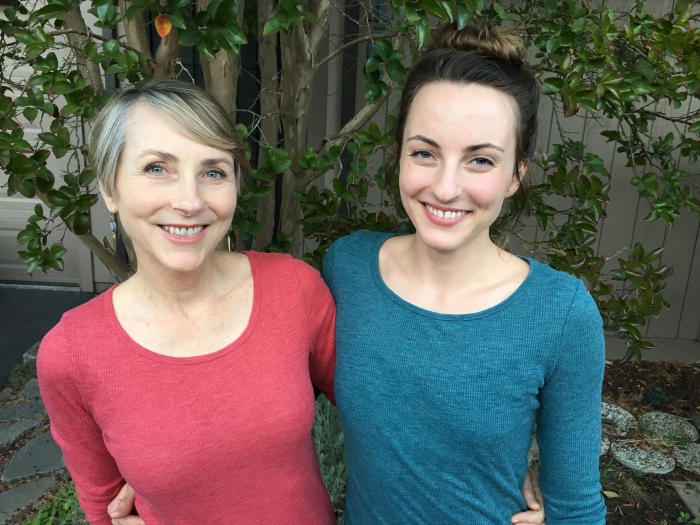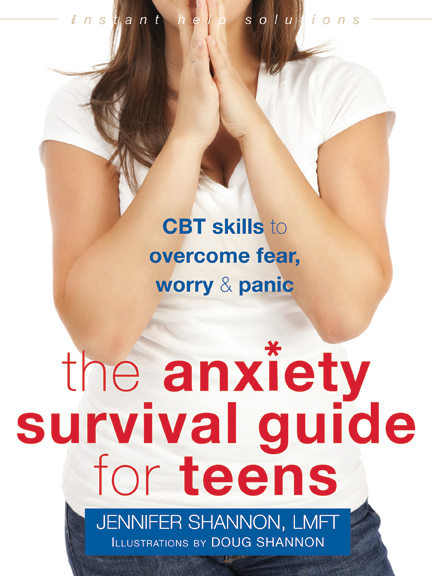By Jennifer Shannon, LMFT, author of The Shyness and Social Anxiety Workbook for Teens, The Anxiety Survival Guide for Teens, and Don’t Feed the Monkey Mind
I will never forget the morning I pulled the covers off my daughter, telling her in my firmest voice that she had to get out of bed NOW. From the beginning of sixth grade it had been a struggle, but with a firm hand, I was able to get Rose out of bed and off to school. But this morning we’d hit a wall. She looked at me with genuine dread. “Mom,” she said, “I would rather die than go to school.”
My beautiful daughter had developed severe social anxiety disorder. On her “good” days at school she survived by avoiding social interactions, often hiding in the bathroom during recess and lunch breaks. On her worst days she had full-blown panic attacks and went to the office complaining of stomach aches and asking to be sent home. While there was nothing physically wrong with her, I knew her distress was real. And as a parent, I was suffering too.
The reason I knew what was wrong with her is that I am a cognitive behavioral therapist who specializes in treating children and adults with anxiety disorders. I knew how treatable her condition was and I was aching to help her, but predictably, she didn’t want her mother to double as her therapist. We live in a midsize town, but it can be very hard to find a cognitive behavioral therapy (CBT) therapist who is well trained in the treatment for anxiety. I sent her to two different therapists, neither of whom were helpful to her. I knew from working with hundreds of families that finding the right kind of treatment can be a frustrating problem. We decided to try to work together on the problem, and to try not to get caught up in the roles of therapist and client.
I explained to her that the active ingredient for the treatment of social anxiety disorder is gradual exposure to feared situations. Rose knew her feared situation was school, and she truly wanted to try, but her anxiety felt overwhelming. We needed to lower the bar somehow. Perhaps, we thought, she could do better in a smaller school. Disclaimer: changing schools isn’t something I’d recommend for my social anxiety clients, but it’s what we did, so it’s part of our story.
School Accommodations for Social Anxiety
Before her first day at her new school, I met with the principal, the school counselor and the teacher to explain social anxiety disorder to them. They’d seen plenty of it before, but they needed to know the importance of gradual exposure. The accommodation we agreed on was to pair Rose with a classmate who would show her around and help orient her to her new school. If she had a panic attack at school, she would have permission to go to the office until she calmed down, but would need to stay at school. The stage was set.
Gradual Exposures
It was over ten years ago, but I remember driving Rose to her new school as clearly as if it happened yesterday. We were both nervous—she about a new school, and I about whether our plan would work. Would she get out of the car? Would she stay at school? Would she keep hiding in the bathroom during lunch and breaks?
To get her started interacting with new peers, I made a modest proposal. If she smiled and said “Hi” to three students that day, we’d stop for ice cream on the way home. She agreed, but without much confidence or enthusiasm. I had all day long to wonder whether three was too many. Maybe just one would be enough of a challenge.
But Rose did it! She made it through that first day, and we both enjoyed a well-deserved stop for ice cream that day. From then on, every morning on the way to school we thought up new exposures for her to do that day. Asking others for their email addresses developed into actually emailing someone, which developed into getting phone numbers, and eventually, actually making a phone call. Over time her anxiety decreased, and she made some friends.
Rose’s social anxiety didn’t disappear. It continued through middle school and into high school, but it was no longer a social anxiety disorder. Rose was able to function despite her anxiety. She understood that the only way through it was to continue to face her fears over and over again, and every day she attended school she did just that.
At age nineteen, Rose made a beautiful YouTube video about her experience with social anxiety. If you’d like to hear it in her own words, click on the link. Then share it with someone you know who is struggling with this very common and very treatable disorder.
Epilogue
Rose has always been an avid reader, and when she developed social anxiety, I wanted to buy her a book for teens about this disorder. To my surprise, there were none. Social anxiety is the most common type of anxiety there is, and the typical age of onset is adolescence. This is what inspired me to write my first book, The Social Anxiety Workbook for Teens. I did not want other teens and their parents to suffer thinking they were alone and not knowing how to help themselves.
Jennifer Shannon, LMFT, is author of The Shyness and Social Anxiety Workbook for Teens, The Anxiety Survival Guide for Teens, and Don’t Feed the Monkey Mind. She is in private practice in Santa Rosa, CA, and is a diplomate of the Academy of Cognitive Therapy.



 2024 Peace Playbook: 3 Tactics to Avoid Clashes with Your Partner
2024 Peace Playbook: 3 Tactics to Avoid Clashes with Your Partner